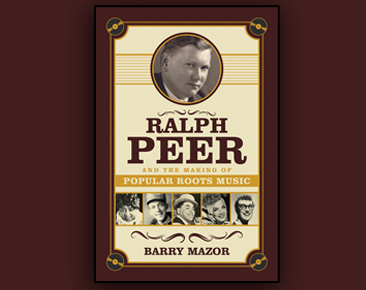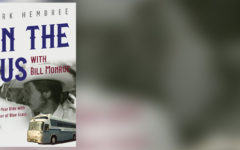
 Ralph Sylvester Peer is recognized for his part in the July/August 1927 Bristol, Tennessee, recording sessions which introduced Jimmie Rodgers and the Carter Family to the world.
Ralph Sylvester Peer is recognized for his part in the July/August 1927 Bristol, Tennessee, recording sessions which introduced Jimmie Rodgers and the Carter Family to the world.
In Ralph Peer and the Making of Popular Roots Music, Barry Mazor relates the momentous events of that period in some detail, as they deserve. This chapter in Peer’s life comes on page 96 in a narrative 283 pages long. Beginning at the age of 11, Peer had already earned a life-time of credits working in the record business. I say record business because his main interest was in the selling of records.
Peer was “a quiet, conscientious, studious sort of child,” he “would always have an introverted side that favoured undisturbed, quiet, solo situations.”
Initially, Peer worked for Columbia Records, learning about what the ingredients were that made a successful record.
In 1920 he was hired as recording director of General Phonograph’s Okeh Records. That same year Peer recorded Mamie Smith, making the first blues recordings specifically aimed at the African-American audience.
For Peer, that was the first in a career of pioneering events. And he was a pioneer extraordinaire. He was also a very shrewd operator, almost always ahead of the competition.
He is also credited with what is often called the first country music recording; to wit Fiddlin’ John Carson’s Little Old Log Cabin in the Lane that was backed with That Old Hen Cackled and The Rooster’s Goin’ to Crow (in June 1923).
Jelly Roll Morton (London Blues), Henry Whitter (Wreck of the Southern Old 97), Bascom Lamar Lunsford (I Wish I was a Mole in the Ground), Roba Stanley (Single Life, the first female country solo record), Ernest V Stoneman (The Titanic), Lonnie Johnson (Mr Johnson’s Blues) and Emmett Miller (Lovesick Blues) all made their recording debuts for Peer in the years leading up to and including 1925.
Also it was Peer who initiated the Hot Fives and Hot Sevens’ sessions, considered the most significant in Louis Armstrong’s career and in jazz history, as a whole.
Then, of course, are the famous Bristol Sessions, which led Peer to strike up management deals with Jimmie Rodgers and the Carter Family. (By this time Peer had moved to Victor/RCA Victor and established Southern Publishing.)
The attraction for Peer was twofold; he was finding musicians who were instantly saleable in a distinctive market and they were able to provide good, original material that he was able to copyright.
In addition to the continuing recording output from Jimmie Rodgers and the Carter Family, Memphis Jug Band, Blind Willie McTell, Leo Soileau and Maius Lafluer, Fats Waller, Bukka Washington White, King Oliver, Hoagy Carmichael, Memphis Minnie and Benny Motens Kansas City Orchestra
As he moved away from A&R work to concentrate on publishing, Peer looked to Central and South America for new, original material. He travelled innumerable times throughout the regions, working to popularise Latin American music in the US during World War II.
His business model included an expansion with offices worldwide. This began in the 1930s as he opened offices in London, Paris, Rome and Madrid. However, World War II affected his plans to increase the number of offices initially but, eventually his aims were realized.
Peer would travel to his offices frequently. This enabled him to enjoy another passion, one that had begun in childhood, that of gardening or, more particularly, a love for camellias. He would acquire camellias on his travels and plant them on his Park Hill estate on Hollywood Boulevard. Peer became such an expert on camellias that he became President of the American Camellia Society and he was honored by the Royal Horticultural Society as well.
Ralph Peer was very supportive of the fledgling BMI (Broadcast Music, Inc.) by setting up a new publishing firm Peer International, as a BMI signatory, and assigning much of his catalog – those songs not linked to ASCAP – to BMI. From BMI’s point of view, that gesture was crucial in the success of BMI, a life-giving link-up.
Peer worked with Walt Disney by bringing music that he recently acquired to the soundtrack of Saludos Amigos, Disney’s animated feature set in Latin America.
That started a concentrated working relationship that led to them collaborating on many more films, and was enhanced by a friendship that was enjoyed not only by Peer and Disney but by the latter’s wife Lilly and by Monique, Peer’s third wife.
Peer was actively involved in the inception of the CMA (Country Music Association), and such was Peer’s wide-ranging contribution to the genre that the organisation elected him to the Country Music Hall of Fame in 1984.
His last big discovery and client was Buddy Holly, publishing the big hit That’ll Be the Day.
He had an amazing life; all the more so considering the shyness that characterised his youth. Peer’s name lives on not just for his contributions to music of varying styles, but with an annual prize for camellias.
Peer passed away in 1960, of pneumonia, but his business innovations are still relevant 55 years after his death.
So impressed were the Peer family with Mazor’s book about Jimmie Rodgers that they invited him to write Ralph Peer’s biography. They allowed access to all of Peer’s papers and supported him throughout the process.
He has written a fascinating and riveting story, very well told. Mazor uses language well and has a fluid writing style, a sure sign of an articulate and experienced writer, with the very occasional aside in more down to earth language.
In addition to some notes and an index is an appendix listing Peer’s key recordings and published songs during the period 1920 to 1960; a very thoughtful asset.
There are two groups of small black and white photographs.
Hardcover: 316 pages
Publisher: Chicago Review Press (1 Nov. 2014)
Language: English
ISBN-10: 1613740212
ISBN-13: 978-1613740217
Product Dimensions: 3.2 x 16.5 x 24.1 cm







